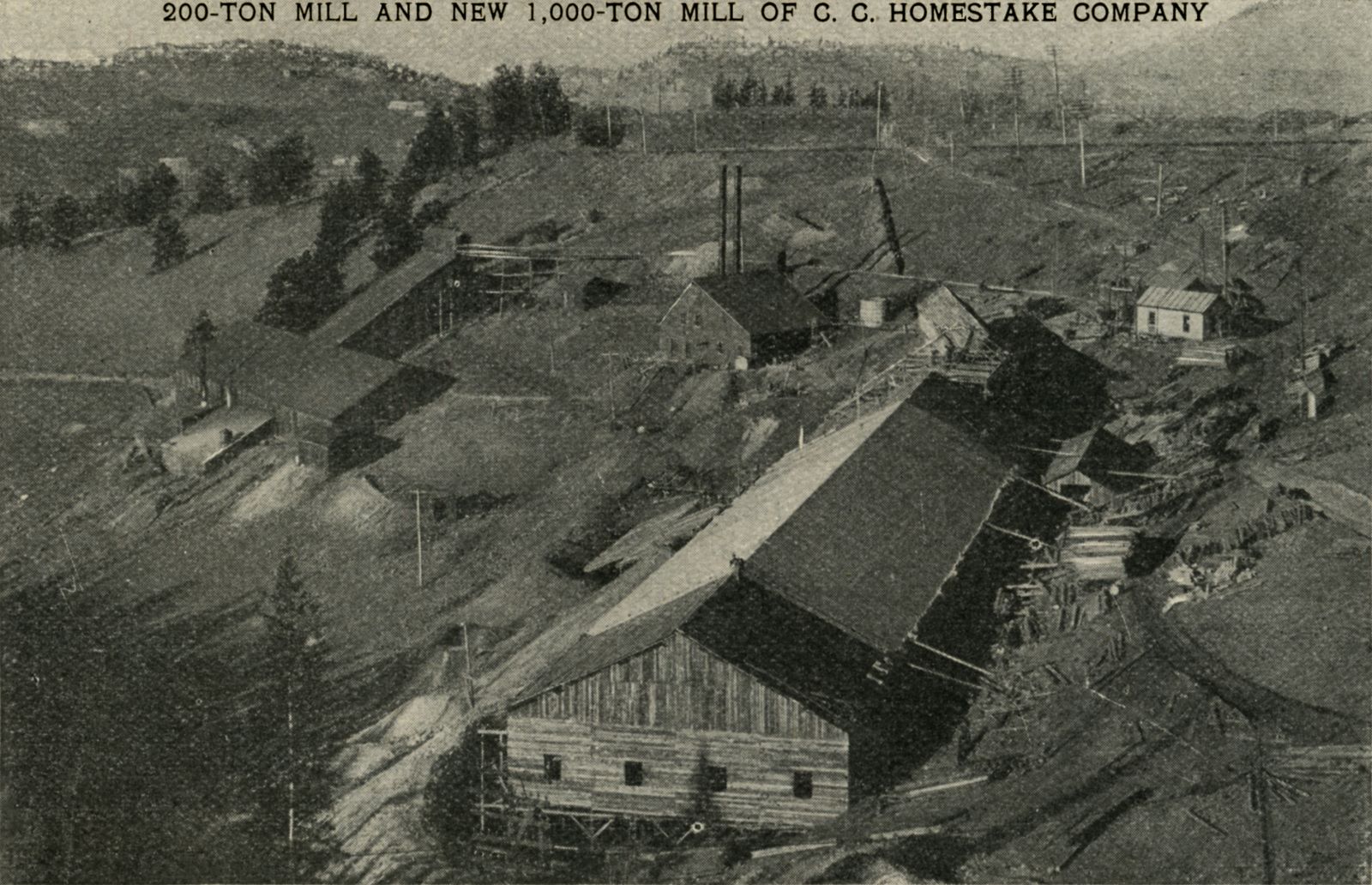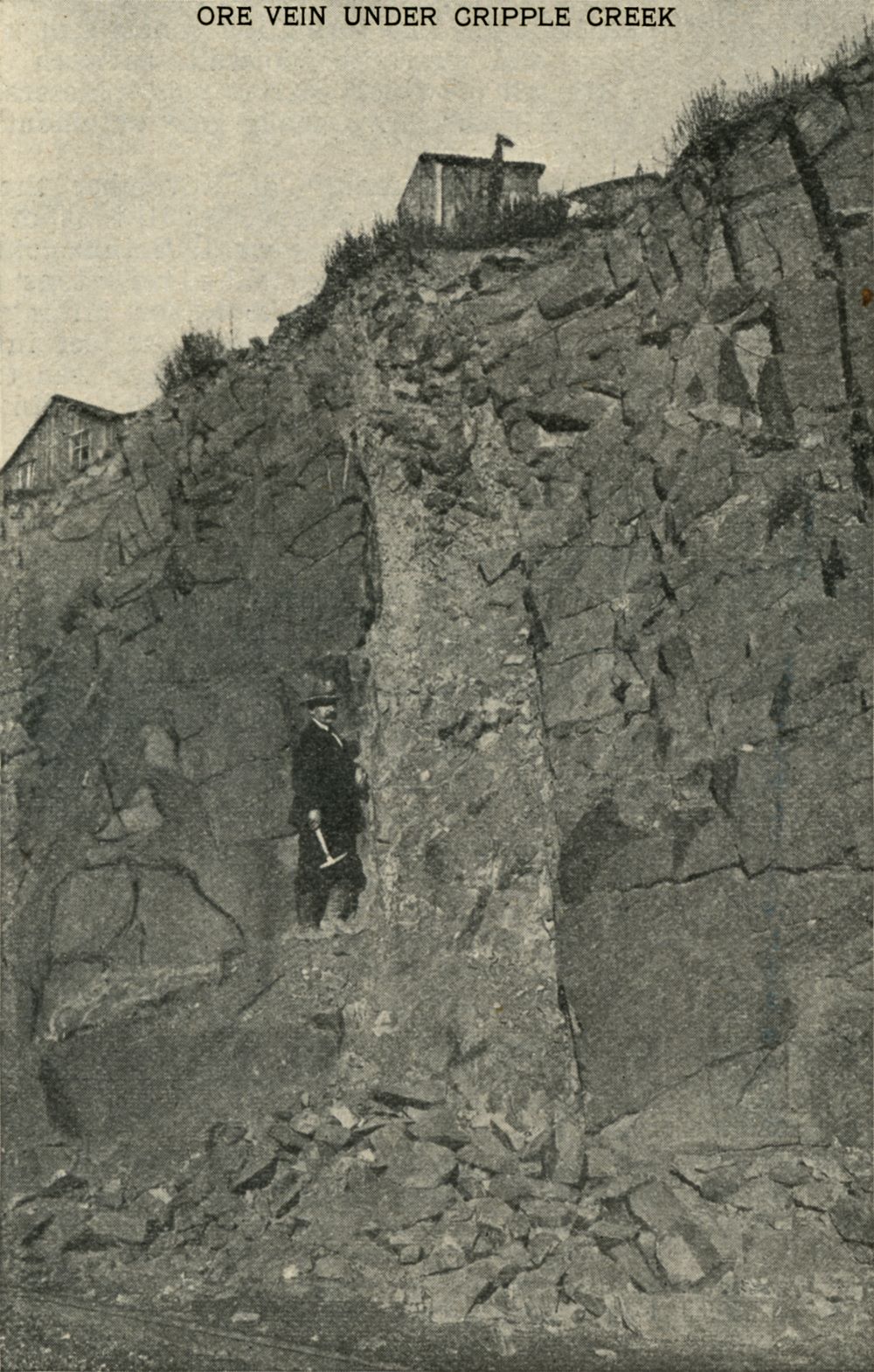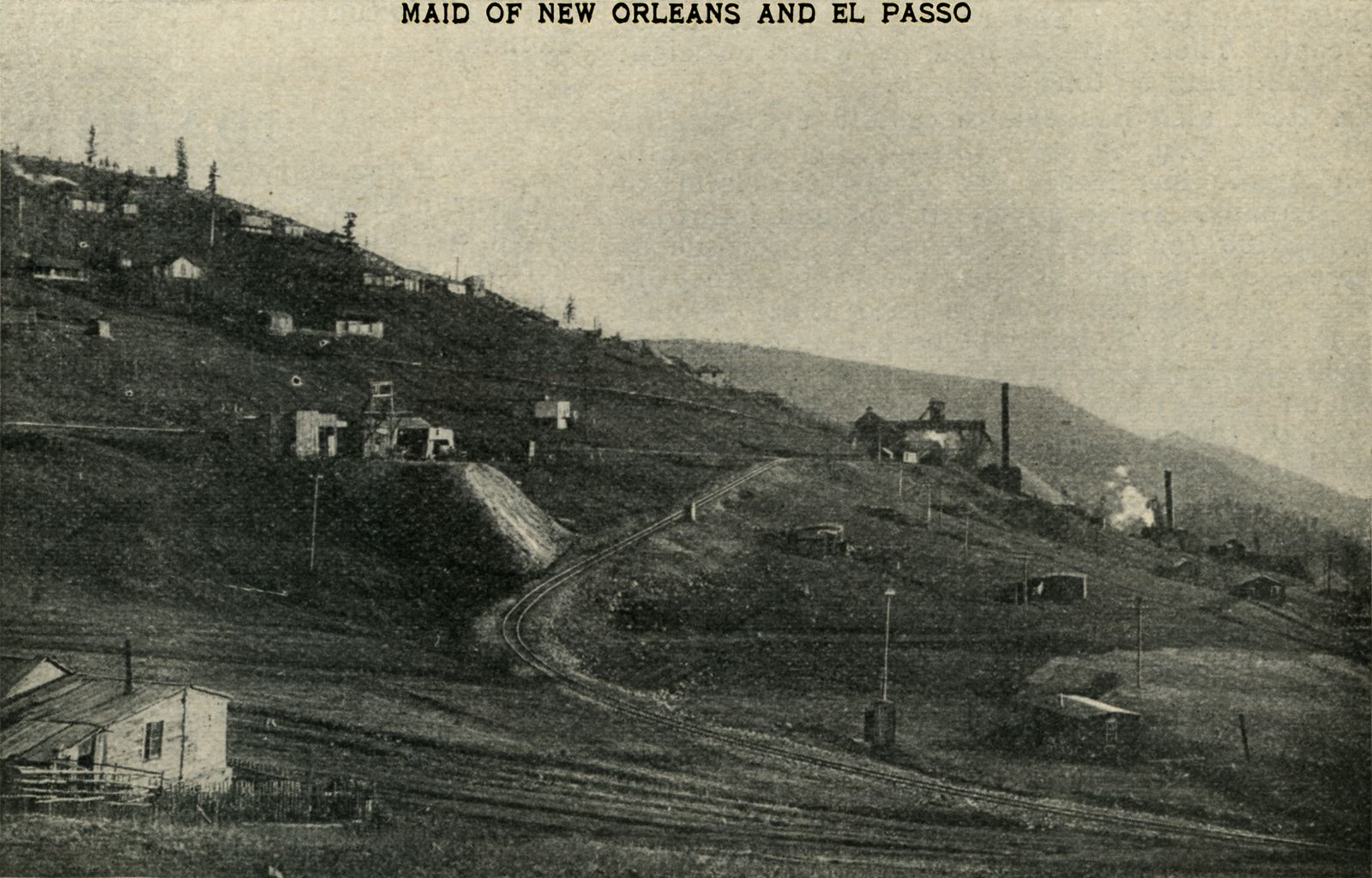-> My Collection; No source to show as I've not scanned the Mining Journal as an album.
(page 644-646)
From THE MINING WORLD'S Staff Correspondent.
Nine months ago your correspondent reviewed the operations of the Iron Clad mine property and 200-ton cyanide plant they recently completed, which had just produced its first gold bricks as a result of a two weeks' run of the plant. This The Mining World published with several illustrations of the mine and mill. The success of this mill inaugurated the cyanide era of the Cripple Creek district.
Since that time the C. C. Homestake Mining and Reduction company, which owns the property, has erected and nearly completed a plant with 1,000 tons capacity, which, with the first mill, both running full capacity, will treat 1,200 to 1,500 tons of ore each 24 hours. The new tank building is 700 feet long, and an engine boiler and shaft house will give 200 feet more under cover. It is said to be the largest cyanide plant in the United States.
Messrs. C. E. Miesse and E. A. Norton were the active factors in establishing this great enterprise within the year. The company has paid seven or eight dividends during that time.
These gentlemen, in association with others, have recently organized the City of Cripple Creek Gold Mining company, which has taken over the Enterprise mine and property, located in the heart of the city, together with the exclusive franchise to mine under the city of Cripple Creek, which franchise has been extended to 25 years, and confirmed by the city authorities, to this company.
The board of directors and officers of the company are;
- E. A. Norton, president
- J. D. Farnham, a capitalist, of Iowa and South Dakota, vice president
- C. E. Miesse, secretary
- J. D. Greve, capitalist and merchant, of Iowa, treasurer
- C. S. Simpson, banker, is director.
The franchise to mine under the city is on the low basis of seven and one-half per cent royalty on ore of $50 or less value, transportation and treatment charges being first deducted, and ten per cent on ores of over $50 value. The company is also exempt from taxes upon its mining privilege.
A trip through the underground workings of the company and over the surface shows strong, well-defined veins, well mineralized, some of them of unusual width. The main shaft is 210 feet deep; 500 feet of cross cutting and drifting has been done, and will continue until all the known veins are cut.
The company has been greatly aided in its underground work by the fact that its principal veins have been exposed by the cutting of the streets and railroads through the ledges above, and in the excavations for water, gas and sewer pipes and foundations of buildings.
The shaft will be extended to 500 feet depth. Just above this mine, in Poverty Gulch, is the famous Abe Lincoln mine, which has produced for ten years, and some of its ore had been among the richest ever taken from the district. It is now owned by the Stratton estate, and is under lease to Walter Swanson, also one of the successful mining men of this camp. It is thought that the rich ore shoots of the Abe Lincoln will be cut within the 500-foot depth.
Among the veins that are exposed by surface cuttings is the City vein, near the city hall, from which a shipment was sent out which gave a value of $50 per ton. Assays have been obtained up to $200 and even $1,337 per ton. Running at right angles to the City vein is another four feet wide, opened by the Midland road, in cutting into the hill for its track. Within 100 feet of its depot, at the foot of Bennett avenue, at the junction of these two veins, within 250 feet of the shaft, it is expected will be opened unusually rich ore.
Another vein, one and one-half feet wide, was cut 150 feet west from the Short Line depot, and 400 feet southwest from the shaft.
A porphyry dyke six feet wide is exposed on west side of Fifth street, a block and a half from the National hotel, and an immense basalt dyke was also exposed in cutting this street. The dip of these two dykes indicates a junction at about 100 feet depth, and the surface assays lead to the expectation of good results being obtained at this junction.
In the Abe Lincoln high sylvanite values have been very largely in granite, and in this property a fine granite vein, above and near the National hotel and the high school, assaying $20 to $40, was uncovered. A four-foot vein was also opened near the Baptist church on Third street. While excavating for the basement another vein was opened just east from the National hotel, under Scheidin & Lehman's photograph gallery.
Under the Collins hotel, two blocks from the shaft, a four and one-half-foot vein was discovered while blasting for a basement. This gave assays of $60 to $181 per ton.
Three veins outcrop on the surface in three vacant lots on the south side of Myers avenue, and $40 per ton was returned from a shipment from these. The conditions set forth above enable the company to explore beneath the surface with certainty as to the location of valuable veins, and it is a practical certainty that in depth there will be exposed great shoots and veins of good pay ore, with much high grade, such as is opened to greater or less extent in all parts of this wonderful gold bearing district.
Touching the El Paso on its north end and the Chicken Hawk on its south end lies the Maid of Orleans, a claim which was opened to a depth of 400 feet some years ago by its owners, who then patented the claim and ceased work. Within the past two years the El Paso mine has been developed from a prospect into one of the richest and most valuable mining properties in the district.
It shipped a few months ago one and one-half tons of selected ore, which brought nearly $80,000. Much of its rich ore has been taken within 200 feet from the south end of the Maid of Orleans, the shaft of which is near its south end.
This property, the Maid of Orleans, has been obtained under lease by the City of Cripple Creek Gold Mining company, and will shortly be equipped and operated by that company. Before the closing of operations in the 400-foot shaft a promising porphyry dyke was cut, of the same character, and undoubtedly the same as that which accompanies the formation and veins in the El Paso.
The El Paso has ore enough in its workings opened up to produce dividends for two years, and has hardly begun to explore its ground. On the north the Chicken Hawk has been a producer for years. It would, therefore, seem certain that the City of Cripple Creek company has a most valuable asset in the Maid of Orleans property.
The El Paso has declared its third monthly two cents per share dividend and expects to continue them for an indefinite time.
The Portland mine has produced about 16,000 tons of ore during December, which is believed to be the largest production in its history. Five thousand tons of this was smelting ore, 3,000 tons from assorting the dump and the balance milling ore. The average value is from $20 to $35 per ton. Although it mills are down to ten dollars per ton, possibly to a less value, about 600 men are employed, the largest force employed upon any mine in the district, and this has been the case most of the time since the camp has become a great producer.
The principal lease on the Gold Sovereign expires in February, when the company will take up the work. The Gold Sovereign M. & T. company has $40,000 in its treasury, and will declare a one-half cent per share quarterly dividend on January 3 at the annual stockholders' meeting. There is ore in the 700-foot depth, which is the ninth level, and the indications point to continuance in the levels below. It is rumored that the company will erect a 200 to 500-ton cyanide plant early in the year.
The R. E. A. & A. M. & M. company, leasing on the Wild Horse on Bull hill, has voted to increase its capital stock, which will be used to increase the capital of its cyanide plant from 100 to 200 tons a day. Mr. E. A. Asmussen, a successful business man of Cripple Creek, is the president of this company and its principal stockholder.
The Wild Horse has immense dumps, which can be profitably milled, and oxidized ore in its workings extends to 1,000 feet depth. There is considerable shipping grade also opened up. The property was a great producer in the earlier days of the camp and gave the Woods Investment company, its controlling stockholder, a great income.
Bad air was one of the causes of its being closed for several years prior to its lease to the R. E. A. & A. M. & M. company. It promises now, under the cyanide treatment, to renew its past reputation and yield up its store of yellow metal for still many years. Allen Morrell is vice president and secretary of the leasing company and has the general management of the company.
R. P. Russell, W. G. Rice and associates, it is said, are getting ready to construct a 1,000-ton cyanide plant to treat the ores coming from their lease on the Stratton property on Globe hill. The cost of mill and other machinery complete is expected to reach $100,000.
The Tutonic mine, on the north slope of Ironclad hill, within 600 feet of the W. P. H., is under lease to Messrs. Cain & Duncan. The shaft is down 240 feet, and there are stringers of ore opening up running $180 per ton in value. The outlook is promising. They are now drifting on the ore on its dip. It is planned to sink the shaft 300 feet deeper to get at the main ore shoots.
The Gold Coin continues to take out good ore from the discovery made a month or two ago in the 1,100-foot level. It runs about $30 value. This is the deepest pay ore being worked in the camp. At the seventh level some ore worth $30 per pound has been taken. In what is called the Parallel vein, at the 1,100-foot level, there is two to three feet of ore in bunches running $1,000 to $2,000 per ton.
The Pharmacist, W. F. Rock president and manager, has leased out its levels in blocks. The company runs the hoist and finds all the mining supplies and tools. The royalty is placed at 50 per cent. There are 25 men at work on eight leases, shipping 50 tons a month.
Mr. Rock also has charge of and controls the Gold Bond Con. Mines company, on Gold hill.
H. J. Austie has leased the Comstock claim of this company. He is down 100 feet and following vein, paying for the work from the proceeds as he goes. He opened fine ore recently in the Old Painter vein, which extends into this ground.
The Hummer block has just been leased to R. P. Russell, formerly of Russell & Sharp. The old shaft on this ground has produced $100,000 from a 125-foot incline. Mr. Russell will sink a new shaft 400 feet - 200 feet first year of his lease and 100 feet each following year.
Mr. James Bussert, proprietor of the National hotel, who is interested in the molybdenum property near Crested Butte, in Gunnison county, says that Adelbert H. Richards, chief chemist of the Vindicator mine, has tested the ore from that property and obtained 26 per cent, of molybdenum. There was some magnetic iron easily removed, and the ore will easily concentrate. Mr. Bussert is well satisfied with the prospects.





![Photo by: J.E. Stimson, 1903 | Click for larger view, more info Mary Mckinney Mine [as Seen From Gold Hill]](/04library/images/mining_world/1904-12-31_p646-crpd_mary_mckinney_mine_6d_scrn.jpg)